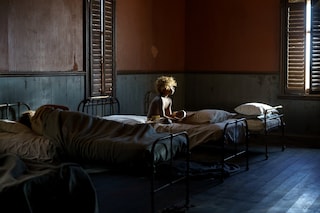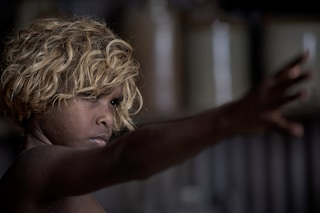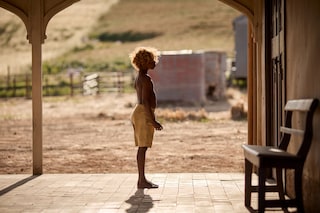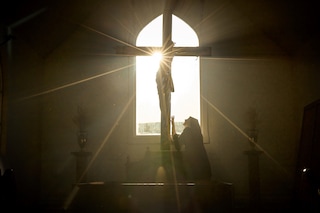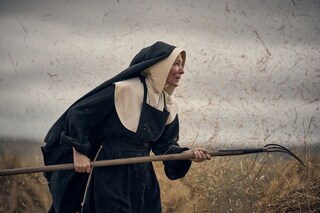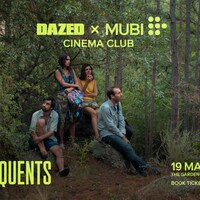The Oscar-winning actress speaks to Nick Chen about The New Boy, where she stars as a renegade nun in the Australian outback
“I’ve got to come clean,” Cate Blanchett admits with a devilish grin. “I’ve always wanted to play a nun.” After tackling everything from Bob Dylan in I’m Not There to an Elf in The Lord of the Rings, Blanchett’s prayers have finally come true: in Warwick Thornton’s magical-realist drama The New Boy, the 54-year-old Australian actor stars as Sister Eileen, a wine-drinking, Jesus-loving nun who runs a remote monastery in Australia during World War Two. “They’re such mysterious figures, particularly cloistered nuns,” Blanchett observes. “I’m fascinated by the concealment.”
Co-produced by Blanchett’s company Dirty Films, The New Boy unravels as an entrancing clash of beliefs. An aboriginal boy around the age of ten, played by newcomer Aswan Reid, is captured by police on horseback and brought to Sister Eileen’s orphanage to be indoctrinated into Christianity. The unnamed child, though, arrives with his own Indigenous spirituality, as well as magical powers glimpsed through orbs of light generated from his fingertips. Such is the boy’s impact upon Sister Eileen, who has secretly taken over the monastery after a priest’s death, the film could alternatively be titled The New Sister.
“We find Sister Eileen in a crisis of faith,” says Blanchett, speaking over Zoom from her UK home. “She doesn’t want another priest to come in. There’s a sense that the boys haven’t been treated well by that priest, which is a narrative we very much understand historically in the Catholic Church – you know, the abuses that went on there. So how long can she stave off the outside world and protect the children? Yet she herself is quite fragile.”
As a child, Thornton, a 53-year-old Kaytetye filmmaker, was raised at a boarding school run by Spanish monks. There, he encountered Christianity, much like the eponymous new boy does when Sister Eileen introduces him to a wooden statue of Jesus on a cross. In the early 2000s, Thornton even wrote a script, The Father and the Son, inspired by his upbringing, Australia’s colonial past, and the country’s “breed out the Black” policy whereby Aboriginal children were taken from their parents and handed to white families. When a draft was sent to Blanchett during the pandemic, it centred around two male characters.
“If you see a priest and a young, Indigenous boy on a poster, you think, ‘I know what that film is, and I don’t want to see that,’” says Blanchett. “My partner, Andrew Upton, suggested to Warwick that if he flips the gender and makes the priest a nun, suddenly there’s a whole layer of compilation. It became a powerful film about absent fathers, and people trying to establish a matriarchal system.”
Much like Tár, another film in which Cate Blanchett plays a know-it-all white woman challenged by young people of colour, The New Boy possesses a dark sense of humour that doesn’t undermine its serious subject matter. Take, for instance, the speed at which Sister Eileen glugs alcohol, or the audaciousness of a winking Jesus statue. It also marks a sly shift for Thornton, a filmmaker whose acclaimed features – in 2009, Samson and Delilah won the Camera d’Or at Cannes – were known more for their visual poetry than surreal jokes. Much of that, the director claims, comes down to Blanchett.
“It’s scary writing for bonny Cate because she can handle a 20-page monologue, but that’s not the kind of filmmaker I am,” says Thornton on a separate call from LA. “I’d rather watch someone think than speak. If you give bonny Cate less, in a strange way she’ll give you more. We changed it from a priest to a nun, but we kept the physical arc. Even though she’s a nun, she still has to do all the monk shit. That’s rock ‘n’ roll for her. She’s playing a bloke, but she’s playing a nun playing a bloke, which is really bizarre.”
Not only did Thornton resist overwriting for Blanchett, the New Boy barely speaks a word the entire film. Subsequently, a swooping score by Nick Cave and Warren Ellis fills in the gaps. Thornton recalls, “I rang them up, and said, ‘You know how I said I might need a bit of violin and piano? I kind of want 50 cellos and 150 violins.’ They went, ‘Here we go. Another bloody director annoying the shit out of us.’ They weren’t interested in seeing the image, which I found empowering. They read the script and played from their emotion. They smashed it out of the park.”
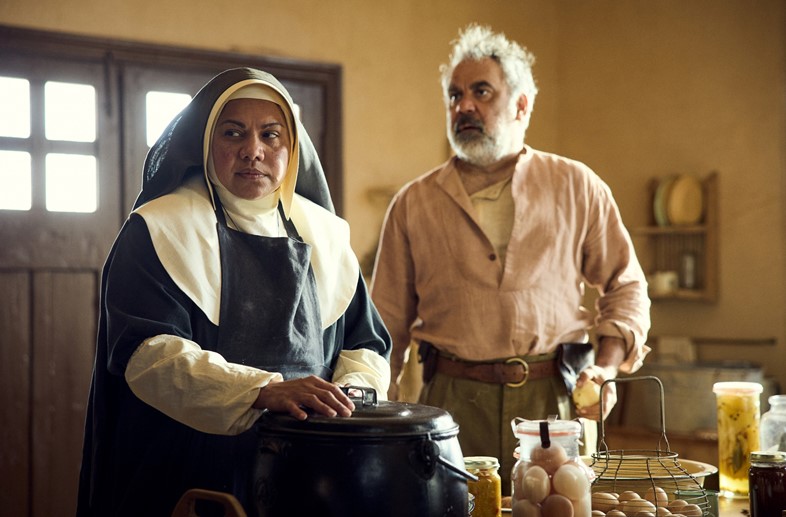
Thornton also sought inspiration from European painters such as Caravaggio for composition, and Australian artists for colour. While he believes the best cinematography is the cinematography the viewer doesn’t notice, he couldn’t resist filling the frame with memorable, sometimes biblical images. “If you make it all good, you don’t notice the cinematography,” the director says. “It’s like Dune – it all looks good. If you don’t realise that it’s all bloody amazing, then you get sucked into the arc of the characters.” So this is his Dune? “It’s my Dune-and-Days-of-Heaven cinematography kind of wank that I think I got away with.”
Likewise, Blanchett praises Thornton’s visual framing of Sister Eileen within a patriarchal system, as well as the ongoing question marks around her character. “She’s officiating mass, which is something priests do, not nuns,” says Blanchett. “There’s a sense that all of them have dark secrets. Of course, any country that has been colonised has a Pandora’s chest worth of dark secrets in their culture.” Meanwhile, Sister Eileen’s fretful gesticulations are juxtaposed with a child who stares at her in perplexed silence. “People are always reading meaning into him, which is what happens with religion,” she says. “Things take on spiritual significance because we can’t give voice to the depth our soulful feelings.”
It’s revealed that among the boy’s powers is the ability to mend wounds and even reverse death. The child is, then, likely a Ngangkari healer, albeit a fictionalised version whose gifts embody a more magical form. “In Indigenous culture, there’s a whole connection to time and history I don’t have the right to discuss,” says Blanchett. “He was displaced, and didn’t have the chance to step into that power. The tragedy is the incuriosity the Catholic Church has in relation to that Indigenous spiritual power, which has so much to offer. It doesn’t end up melding in a new way of looking at things.”
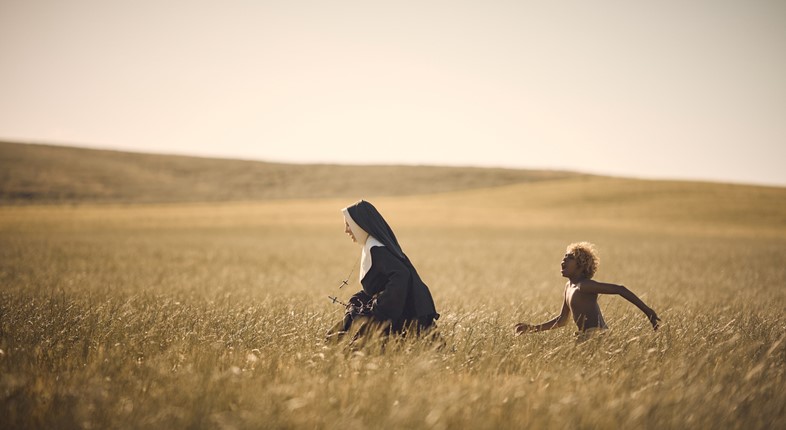
Thornton teases that he and Blanchett might work again on a “remake of Faust in modern-day New York”, while the actor’s upcoming films include Jim Jarmusch’s Father Mother Sister Brother (“not that kind of sister,” she interjects) and Guy Maddin’s Rumours (“one of the most joyous experiences I’ve ever had,” she beams). Meanwhile, The New Boy is still slowly making its way into cinemas nearly a year after its Cannes premiere – now 96 minutes long, rather than 116 minutes.
“I was sitting at San Sebastian, going, ‘Oh my God, this film has three endings,’” says Thornton. “It needed to be shorter. It needed to be quicker. I dictate a film on how sore my bum gets in a cinema. Three-hour films are perfectly designed for streaming.” So this isn’t actually his Dune? “Sadly, I’m one of those who will wait for [Dune] to be on VOD. I can’t sit for three hours. It’d drive my fucking mad. I’ll watch it on my iPad.”
Moreover, Blanchett believes that The New Boy, with its elliptical imagery, will be relatable to audiences in the modern age. “You don’t particularly know what time period you’re in, but you sense there’s a war out there,” she says. “People are protecting these children from the outside world. That’s something we’re all thinking about at the moment, and we’re all waiting for a miracle to happen.” She adds, “You don’t have to be Catholic or a nun to want to be saved from your situation.”
The New Boy is exclusively in UK and Irish cinemas from March 15.

